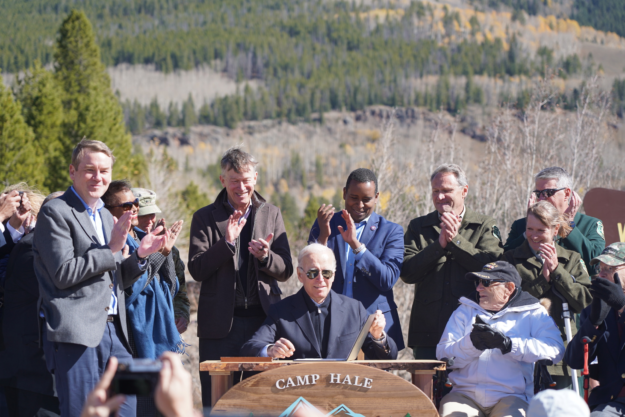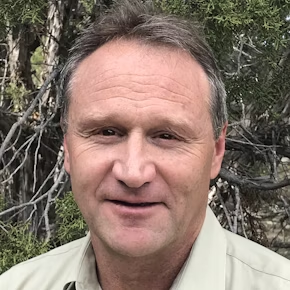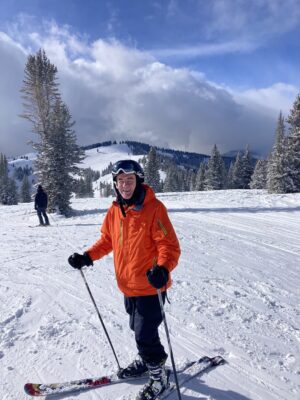Widgetized Section
Go to Admin » Appearance » Widgets » and move Gabfire Widget: Social into that MastheadOverlay zone
Departing forest chief Fitzwilliams says crowding impacts ‘a really hard thing’

White River National Forest Supervisor Scott Fitzwilliams, second to the right behind former President Joe Biden, applauds the Camp Hale National Monument signing in 2022.
After 34 years in the U.S. Forest Service – nearly half of them managing the nation’s busiest national forest in Colorado – White River National Forest Supervisor Scott Fitzwilliams was busy packing up his office on his final Friday of work when a reporter called to ask him about the health of the forest as the federal government slashes thousands of workers.
Fitzwilliams, 60, resigned what he called his “dream job” in order to accept a buyout that will see him paid while on administrative leave through the end of September. His last day in his Glenwood Springs office was Friday, March 14, but Fitzwilliams declined to talk on the record about the circumstances of his resignation or the impacts of all the staff cuts on national forests.
The reluctantly resigning forest chief, however, was happy to talk about the intense impacts of Colorado’s booming outdoor recreation economy on the state’s national forest lands, from huge crowds of skiers in the winter to droves of hikers, bikers, rafters and campers in the summer.
Since assuming the helm of the 2.3-million-acre national forest that stretches from Summit County in the east to Aspen in the south and all the way to Mesa County in the west, Fitzwilliams has overseen a massive surge in visitation – from around 9 million people a year when he took over in 2009 to nearly 18 million in 2024.
So-called “Resort Influence Zones”, where federally owned land surrounds booming ski towns, are seeing more and more impact as visitors from around the world push deeper into the national forests. Deer and elk populations are half of what they were 20 years ago in the Forest Service’s ‘Game Management Units” along the I-70 corridor in Colorado.
With Colorado’s human population surging from roughly 5 million in 2010 to 5.8 million in 2020 — a nearly 16% increase in just a decade – Fitzwilliams wasn’t willing to talk about the impacts of cutting 150 Forest Service managers in Colorado (3,400 nationwide) as well as a freeze on hiring seasonal staff. But he was keen on discussing his own experiences managing doubled visitation over the last decade and a half.
“Hanging Lake [trail in Glenwood Canyon] was an absolute nightmare when it was just first come, first serve, and we were blocking the highway [with cars]. It was crowded. There were so many people and it was fist fights in the parking lot. It was not good,” Fitzwilliams said of implementing reservations and a shuttle from Glenwood Springs in 2019. “So we put in limits and a permit system that has solved that problem.”
He points to similar regulatory systems in highly popular multi-use recreation areas along I-70 such as Vail Pass and even farther afield in the Maroon Bells-Snowmass Wilderness Area west of Aspen, where permits are now required for overnight use: “It was crazy. There was nothing about that experience that was met any wilderness values whatsoever. So, it’s a regulatory thing.”

“And so, in the future, we’re going to have to look at more of that, but it has to be combined with communities and resorts, looking at the overall infrastructure, looking at all the impacts and saying how much is enough?” Fitzwilliams said. “Do we need to keep creating things to invite the entire Front Range to the I-70 corridor every weekend? And that’s a question way beyond the Forest Service. Sure, we can do these planning things, but it goes beyond that.”
Those same questions are plaguing mountain towns during the winter months, with labor and housing shortagesexacerbated by growing numbers of snow riders enticed by multi-resort season ski passes. Traffic, parking and safety concerns have dominated headlines this ski season, and some of the most popular resorts in the nation – from Vail to Breckenridge — are in the White River National Forest. Fitzwilliams said affordability and access are difficult issues.
“We’ve already made these communities unaffordable for people, and that’s happening all over the West. I get it. But those are the resource management options that the Forest Service has in its toolbox, and then balancing it with the important economic role these places play,” he said.
Studies show the White River National Forest with an annual $1.6 billion of economic impact in Colorado, supporting more than 22,000 jobs, but that booming outdoor recreation economy comes with its own set of costs. Fitzwilliams said there needs to be a robust collective conversation between the federal government, state leaders, local jurisdictions, and the business community about the sustainability of increased forest visitation.
“It’s a really hard thing,” Fitzwilliams said. “Or we could make the choice that we don’t need those other values [solitude, wildlife habitat, watershed protection], and that’s OK. We can build more parking lots, build more trails, but you will give up things for that. That is an unarguable fact.”
Unlike Yellowstone National Park, where 96% of the visitation is within 500 yards of the main road system, people get to go wherever they want in the White River National Forest, so the largest increase in visitation has been what foresters call “dispersed and wilderness use.” That includes snow riders who are avoiding resort crowding by heading into the backcountry.
Pushing for the SHRED Act
“The market’s going to drive that,” Fitzwilliams said of ski area crowding issues. But one thing he’s adamant about is more funding from the ski industry coming back to be spent in the impacted national forests. Ski areas pay special-use-permit fees to use Forest Service land, and those fees go up as resort revenues increase.
Fitzwilliams said the impacted forest where every single permitted activity occurs gets some of that money back to mitigate the impacts of the activity: “The only one we don’t is skiers; it’s the only one.” As it stands, all of that money currently goes into the U.S. Treasury.
A bipartisan bill called the SHRED Act (Ski Hill Resources for Economic Development) would rectify that situation, with the majority of the $40 million annually being generated by 124 ski areas nationally operating on Forest Service land coming back to the impacted forests. Colorado, with its dominant ski industry, stands to see up to $27 million a year in “retained ski area fees” to Colorado forests for recreation management, community needs and ski area programs.

Fitzwilliams wholeheartedly backs the SHRED Act and says increasing ski-area permit fees won’t help with the overall impacts of the industry if the money keeps going into the treasury and is not being spent in the forests locally. He emphasizes that all of the permit-fee money would stay with the Forest Service and not go back to the ski areas.
“We could charge them a hundred percent of their total revenue, and if it all goes to the treasury, it doesn’t matter,” he said. “It’s based on the revenue and it’s a little complicated … but the more revenue they make, the more they pay.”
Colorado U.S. Sen. Michael Bennet, a Democrat, has been the lead sponsor on various versions of the SHRED Act dating back several years, along with Republican U.S. John Barrasso. Bennet took some serious heat last month when he posted a photo of himself skiing and pushed for passage of the SHRED Act.
“From A-Basin to Wolf Creek, Colorado’s National Forests are home to some of the best skiing in the world. Senator John Barrasso and I reintroduced our bipartisan SHRED Act to keep ski fees local, bolster Colorado’s outdoor recreation economy, and help our mountain communities thrive,” Bennet posted on Facebook and Instagram.
Reaction ranged from “Read the room, my guy” to “While I appreciate this as a life-long skier, holy crap, how tone deaf are you? This is the literal definition of first world problems. Cheap skiing is really low on Colorado’s list of concerns right now.” One commenter referenced day-ticket prices that have surged past $300 at Vail and other resorts: “Well, I guess if you’re a rich Senator you really don’t care what it costs.”
To be clear, season ski pass prices have been at historically low levels since the introduction of the Epic Pass in 2006, and the SHRED Act is about funding for National Forest management, not necessarily keeping skiing prices down. A spokesman for Bennet declined to comment, sending a link to a press release on the SHRED Act from 2023.
On a press call last month, Bennet called out “these potentially illegal and unfunded [Trump administration] offers for people to be pushed out of the federal government. I mean, even before that, we already were having trouble hiring people at the Forest Service, hiring people at BLM, the western public lands agencies, in a world where I don’t need to tell anybody on this phone call how expensive it’s become to live in Colorado.”
Colorado U.S. Sen. John Hickenlooper this week joined fellow Democrats in introducing the Protect Our Parks Act of 2025 and the Save Our Forests Act of 2025 to “restore the National Park Service (NPS) and the U.S. Forest Service (USFS) workers who were illegally fired by the Trump administration to make sure our national parks and forests remain accessible, safe, and well-maintained.”
In a release, Hickenlooper said: “We’re all for rooting out real government waste and abuse. The Trump administration’s mass layoffs of public servants who care for our public lands and help prevent wildfires is not the way to do it. Colorado – and our economy – depend on the people who carry out this vital work.”
Vail Resorts officials did not provide a comment on staffing cuts at the Forest Service and how they might impact operations, but the company has supported previous versions of the SHRED Act.
Editor’s note: This story first appeared in the Colorado Springs and Denver Gazette newspapers.


